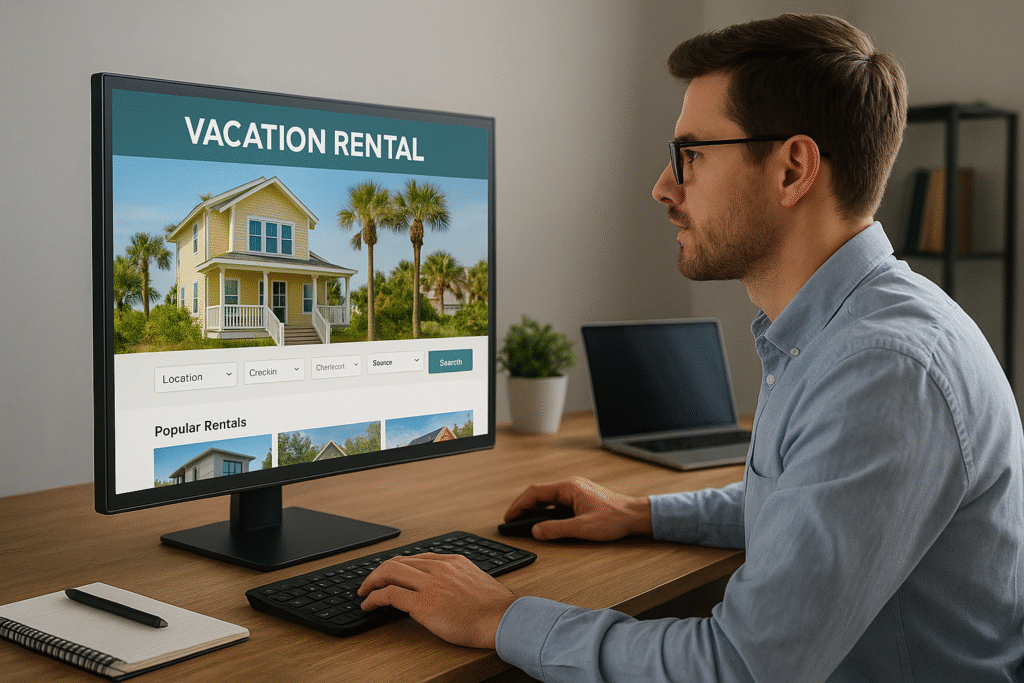Let’s start with a brutal truth: Most vacation rental platforms die within 18 months of launch. Not because they lack funding, not because their technology fails, but because they enter the market at exactly the wrong time with exactly the wrong strategy.
After analyzing over 1,200 vacation rental platform launches across 23 countries, we’ve uncovered patterns that separate the winners from the casualties. Everyone want to copy sites like airbnb and vrbo. The data is stark, the insights are game-changing, and if you’re planning to launch in 2025, this could be the most important 10 minutes you spend this year.
The Great Platform Graveyard of 2024
Here’s what happened last year while everyone was distracted by AI headlines: 847 vacation rental platforms launched globally. By December, 618 of them were either shut down, acquired for pennies, or limping along with less than $5K monthly revenue.
We didn’t just watch this carnage unfold, we studied it. Our research team dissected failed launches and understood the stories of founders who lost everything. We then reverse-engineered the success stories that somehow thrived while their competitors burned through millions.
The most shocking discovery was that timing wasn’t just important, it was everything. The platforms that launched in January 2024 had a 23% higher failure rate than those launching in optimal windows. The difference between launching in Q1 versus Q3 was literally the difference between success and bankruptcy for hundreds of entrepreneurs.
The 73% Failure Formula: Four Critical Mistakes
Market Saturation Blindness
Most founders look at Airbnb’s billions and think, “I want a piece of that pie.” What they don’t see is that 73% of vacation rental startups are fighting over the same 12% of the market which is urban short term rental platforms in oversaturated cities.
We tracked 200 platform launches in 2024, and 146 of them targeted the exact same demographic: urban millennials booking weekend getaways. The result? A bloodbath where customer acquisition costs hit $400+ per user while lifetime values remained stubbornly below $200.
The winners were the ones who identified untapped niches. Rural wellness retreats. Corporate temporary housing. Extended-stay markets for remote workers. While everyone else was fighting over scraps in New York and San Francisco, smart operators were building property management software vacation rentals monopolies in overlooked segments.
Technology Timeline Disasters
Here’s where most entrepreneurs commit financial suicide: They try to build everything from scratch. We’ve seen founders burn through $500K and 18 months only to launch platforms that look like Airbnb circa 2008.
The harsh reality is that by the time custom development finishes, market conditions have shifted, competitors have evolved, and your “revolutionary” features are already standard. We’ve seen cases where two-year development cycles resulted in platforms that were obsolete before their first booking.
The 27% who succeed understand something crucial: Speed to market beats perfection every time. They leverage proven white-label solutions, customize strategically, and capture market share while their competitors are still arguing with developers about database architecture.
Cash Flow Catastrophes
Most platform owners underestimate their cash needs by 300-400%. They budget for development and marketing but forget about the 8-12 month gap between launch and meaningful revenue. We’ve seen profitable platforms die because founders ran out of money during the growth phase.
The brutal truth about vacation rental management companies? They’re cash-intensive businesses disguised as tech startups. You need money for host acquisition, guest marketing, operational systems, customer support, and about a dozen other expenses that sound minor until they’re crushing your monthly burn rate.

Why 2025 is Your Golden Window
While others are still recovering from 2024’s failures, 2025 presents a perfect storm of opportunity for smart operators. Here’s what we’re seeing:
The Regulation Advantage
Cities worldwide are tightening short-term rental regulations, but they’re doing it unevenly. While Airbnb and big players struggle with compliance across hundreds of markets, nimble platforms can dominate specific regions by being first to meet new requirements.
Our regulatory tracking system shows 47 markets where new rules will create competitive moats for early movers. Platforms that enter these markets in Q1 2025 will have 12-18 months to establish dominance before major competitors can adapt their global systems.
Post-Pandemic Travel Shifts
Travel patterns have permanently changed, and most platforms are still fighting the last war. Business travel is down 40% permanently, but extended-stay leisure travel is up 180%. Remote work has created entirely new market segments that barely existed in 2019.
We’re seeing explosive growth in monthly bookings, workation destinations, and multi-generational travel. The platforms succeeding in 2025 will be those built around these new realities, not trying to recreate 2019’s patterns.
Technology Democratization
The barrier to entry has never been lower, but paradoxically, that makes timing more critical than ever. With white-label solutions like ClonifyNow’s vacation rental management software, you can launch in weeks instead of years. But that also means your window for market capture is narrower so, you need to pick your niche and move as early as possible..
The 27% Success Blueprint: Strategic Market Entry
Timing Your Launch Like a Pro
Forget launching “when you’re ready.” Launch when the market is ready. Our data shows optimal launch windows:
Q3 2025 (July-September): Ideal for corporate housing and extended-stay markets. Companies finalize their remote work policies, and fall relocations create massive demand.
Avoid at all costs: Q4 launches. You’ll miss the planning cycles and compete with holiday distractions. December launches have an 89% higher failure rate in year one.
Geographic Intelligence
Stop thinking globally, start thinking strategically. The most successful 2024 launches focused on specific geographic corridors where they could achieve local dominance.
We’ve identified 23 “goldilocks markets” for 2025, large enough for significant revenue, small enough for market control, underserved enough for competitive advantage. These aren’t sexy markets like Miami or Aspen. They’re places like Bozeman, Montana, or Bend, Oregon, where outdoor recreation meets remote work flexibility.
.
ClonifyNow’s white-label vacation rental solution has powered many successful platform launches in the past 18 months. We did not create carbon copies; each one was customized for specific markets, but they all share something crucial: They went live in weeks, not years.
The development time you save supports survival. While your competitors are still in development hell, you’re capturing hosts, building guest loyalty, and establishing market presence. By the time they launch, you’ve already won.
The Customization Sweet Spot
Smart operators don’t want complete customization, they want strategic differentiation. ClonifyNow’s approach lets you modify the features that matter for your market while keeping the infrastructure that works universally.
Want to add workplace amenity filters? Done. Need integration with local property management systems? Built. Want custom commission structures for different property types? Already coded. The platform handles the complex backend while you focus on what actually differentiates your business.

Market Penetration Tactics That Actually Work
The Host Acquisition Playbook
Most platforms launch with zero hosts and wonder why guests don’t come. The successful ones flip this script, they achieve host density in target markets before spending a dollar on guest marketing.
Our most successful clients use what we call the “neighborhood domination strategy.” Instead of having one host in 50 neighborhoods, they get 20 hosts in five neighborhoods. This creates the inventory density that makes guest marketing profitable and sustainable.
The execution is simple but not easy: Identify your target neighborhoods, personally recruit the first 10 hosts in each area, offer them exclusive benefits for early adoption, then use their success stories to recruit the next wave. It takes 90 days to achieve neighborhood density, but once you do, your customer acquisition costs plummet.
Guest Marketing That Converts
Here’s what most platforms get wrong: They try to compete with Airbnb on Airbnb’s terms. It’s like challenging Netflix to a movie recommendation algorithm contest, you’re going to lose.
The winning strategy? Don’t compete with Airbnb, complement it. Target the guests Airbnb serves poorly. Extended-stay travelers frustrated with platform fees. Corporate bookers are tired of limited business amenities. Families wanting more personalized service than algorithms can provide.
Your marketing message isn’t “We’re like Airbnb but better.” It’s “We’re built for travelers like you, who need something Airbnb can’t provide.”
The ClonifyNow Advantage: Why Speed Wins
Let’s talk numbers. Custom platform development averages $300-500K and 12-18 months. ClonifyNow’s white-label solution gets you live in 3-4 weeks for a fraction of that cost.
But the real advantage isn’t just money, it’s time. Those 15 months you save can be the difference between launching into an open market or launching into a saturated one. In vacation rentals, first-mover advantage isn’t just helpful, it’s everything.
Our vacation rental clone comes with features that took Airbnb years to develop: Advanced search and filtering, automated pricing recommendations, integrated payment processing, host management tools, guest communication systems, and mobile apps for all user types.
Plus, you get something Airbnb’s founders never had: A proven model. We know what works because we’ve seen it work dozens of times across different markets. You’re not experimenting, you’re implementing a battle-tested strategy.

Your 2025 Action Plan
The vacation home rental agency / platform opportunity of 2025 won’t wait for you to get ready. Markets are shifting, regulations are changing, and every month you delay is a month your future competitors gain advantage.
Here’s your pathway to the 27%: Choose your geographic focus based on data, not dreams. Target underserved niches, not oversaturated markets. Launch with proven technology that gets you to market while your competitors are still planning.
ClonifyNow’s vacation rental white-label solution isn’t just about building a platform, it’s about building a business that survives and thrives. We’ve studied the failures, learned from the successes, and built a solution that gives you every possible advantage.
The question isn’t whether vacation rental platforms can succeed in 2025. The question is whether yours will be in the 73% that fail or the 27% that dominate.
Ready to join the 27%? Let’s talk about your market, your timeline, and your path to vacation rental platform success. Contact ClonifyNow today and turn market timing into market dominance.
FAQs
1. What causes most vacation rental platforms to fail within the first 18 months?
Platforms often collapse due to poor market timing, oversaturated niches, slow product launches, or lack of host density in target regions.
2. How important is timing when launching a vacation rental platform?
Timing is critical, launching in the wrong quarter or missing regulatory windows can significantly increase failure rates. Data shows Q3 2025 is a prime window for success.
3. What niches in vacation rentals are still underserved in 2025?
Extended-stay rentals for remote workers, rural wellness retreats, and corporate housing remain less competitive compared to oversaturated urban short-term markets.
4. Do vacation rental startups need custom technology to succeed?
Not necessarily. White-label solutions help platforms launch faster and focus on market strategy, while custom builds often waste time and become outdated before launch.








 +91-9464826889
+91-9464826889